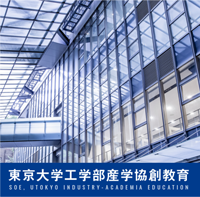Overview
Index
Overview of the Faculty of Engineering
Engineering places an emphasis on science and technology in society. It is obvious that modern society will not function for even a day without taking advantage of science and technology accomplishments. Furthermore, engineering technology supports advanced science.
Engineering places an emphasis on science and technology in society. It is obvious that modern society will not function for even a day without taking advantage of science and technology accomplishments. Furthermore, engineering technology supports advanced science.
Overview of the School of Engineering and Faculty of Engineering
| History | In 1886 the School of Engineering was established with seven departments within the Imperial University. |
| Organization | The School of Engineering is comprised of the Graduate School, originally founded as the primary institution, and the Faculty of Engineering, later established as an annex to the Graduate School. |
| Student body (2023.5.1) | Faculty of Engineering (undergraduate): 2,136 School of Engineering (master’s course): 2,314 School of Engineering (doctoral course): 1,375 |
| Staff (2023.5.1) | Professors, Associate Professors, Lecturers, Research Associates, and Research Assistants: 583 Administrative and technical officers: 214 |
| School of Engineering Departments | 18, plus courses by guest professors and sponsored courses |
| Faculty of Engineering Departments | 16 |
| Affiliated research organizations | Engineering Research Institute (established October 1939) [reorganized]→Institute of Engineering Innovation (January 2002) Nano-system Integration Centere(stablished April 2022) |
The Significance of Learning Engineering
The Significance of Engineering
Not limited to seeking the truth concerning the laws of nature, mankind and society, engineering uses the comprehensively assembled outcomes of such research for productive human practice. To this end, research subjects include materials, the energy transferred by those materials, and systematic research on theories that effectively combine them. Unique engineering theories come from these integrations. Mankind must make decisions at different stages in the fields of productive practice. Design can be used as an example of such an ongoing decision process.
Not limited to seeking the truth concerning the laws of nature, mankind and society, engineering uses the comprehensively assembled outcomes of such research for productive human practice. To this end, research subjects include materials, the energy transferred by those materials, and systematic research on theories that effectively combine them. Unique engineering theories come from these integrations. Mankind must make decisions at different stages in the fields of productive practice. Design can be used as an example of such an ongoing decision process.
Not limited to seeking the truth concerning the laws of nature, mankind and society, engineering uses the comprehensively assembled outcomes of such research for productive human practice. To this end, research subjects include materials, the energy transferred by those materials, and systematic research on theories that effectively combine them. Unique engineering theories come from these integrations. Mankind must make decisions at different stages in the fields of productive practice. Design can be used as an example of such an ongoing decision process.
Engineering is an integrated scientific technique for preparing objective materials so that decisions can be made. Engineering, more than analysis, is a field of integrated study that embraces broad basic and practical applications, incorporates methods, and has the potential to expand in subject matter. Thus, in recent years engineering methods have been applied in fields outside industry as well. Ergonomics, instructional engineering, social engineering, medical engineering, and industrial engineering are examples of such fields. There is some debate as to how developing social problems, such as escalating pollution in high-growth society, defective product production and transportation issues, have been aggravated particularly by the abnormal development of industry, engineering and so on at the core of our contemporary national culture. Regarding this point, that overly optimistic or poor appraisals based on comprehensive engineering were made, and that industrialized society prospects based on an interdisciplinary humanities and social sciences collaboration that pursued an optimal solution lacked policy and public opinion input, and the like seem to have contributed to the difficulties of an advanced industrialized society.
Through such experiences, engineering reexamines the social ideal for industry as well as the significance and role of engineering, and as a science, engineering continues to emerge to have a more comprehensive outlook and consideration. The long history of engineering began with the rise of technology as man first made tools, and it can be said that its fledgling structure continues to grow.
Engineering is what provides a rational basis for human accomplishment, and industry is established on this. In this sense, a wide range of fields including medicine and agriculture become further industrialized. In many spheres of human society engineering carries a responsibility for the issue of how society can develop in a good direction.
There are many underdeveloped fields in engineering, and hopefully your academic interest will be free from engineering and industry stereotypes.
Current and Future Industry
In a one hundred year period beginning in the mid-19th century Japan grew from a small agricultural state into one of the world’s largest industrialized nations. During this period the extent of change in scale and quality of industrialization as well as in rate was unprecedented in the history of the world. Herein lies the primary reason that many developing countries are deeply concerned about the modernization of our nation. Above all, the high growth period in the 1970s was staggering. As a result, the domestic abundance, and a variety of distorted issues behind it, brought about external friction not only among developing countries but also with developed countries.
Nonetheless, the population within the narrow confines of the territory creates a very high-density society; resources, energy and food are absolutely in short supply in our nation; and from now on industry is crucial for supporting the livelihood of citizens. That is not all. It goes without saying that advanced industrial development is essential for enriching human livelihood on a global scale.
The pursuit of an ideal for industry, both domestically and internationally sought since the rapid 19th century growth, remains today. Industries themselves are the ones most seriously considering the future of industrialization in Japan, and industries themselves with the most prospective are the ones predicting that ideal. Industries are trying to find industrialization methods that rely heavily on human wisdom as opposed to the amount of capital, resources and labor. Although this issue is difficult for those engaged in engineering, academically it is extremely interesting and exhilarating work.
The Mission and Position of Engineers
Out in society, Faculty of Engineering graduates undergo thorough professional vocational education and training at their workplace. That is the time to acquire new knowledge and skills. In terms of age, from the upper twenties through the thirties or forties, a trained engineer is involved in cutting-edge research, technological development, product development or design and construction of new plants and apparatus. Beginning as a mid-level engineer, one may work as a team leader after a number of years. Yet in addition to the workplace, during this time one will also play an active role in academic conferences, business circles, government committee or international endeavors. Engineers in their fifties in any field will determine the goals of and courses for new developments in research, technology, products, and so forth with a global outlook and lead their organizations towards those goals.
Regardless which department of engineering one comes from or the field of employment entered, engineers have the abovementioned career development in common. Through this career development, engineers repeatedly have issues expressing themselves in an influential manner. Proper requests, suggestions, and warnings, are not effective unless they are persuasive and authoritative. In any occupation, an engineer’s lifetime is an ongoing struggle of persuasive personal advocacy in acquiring appropriate work conditions. In many cases outstanding engineers who trained themselves over many years to use the “power” of a comprehensive decision previously mentioned in “the significance of engineering” have become prominent leaders in large organizations.
As the ability to think like an engineer filters into every field of human activity, in the future society will expect the promotion of great numbers of engineers to shoulder the increasingly important roles in diverse social fields.
Faculty of Engineering Admissions Guidance
General Notes
Please refer to the “Course of Study Guide” distributed at the time of enrollment for detailed information related to university admissions.
For second year students, departmental guidance (introduction to each Faculty of Engineering department) will be conducted at the Komaba Campus during the summer semester. Alternatively, participation in the admissions guidance session (explanation of the application process) will likely prove to be useful for making decisions about continuing academic pursuits.
Furthermore, to provide you with adequate knowledge about each Faculty of Engineering department, and in order for you to have someone to consult with about attending university, each Faculty of Engineering department will have an academic counselor to personally counsel and discuss admission matters. To request an academic counselor interview, please refer to the Faculty List (Issued by the College of Arts and Sciences. The Komaba Campus Admissions Counseling Office and each Faculty of Engineering departmental office will know as well.), or we will let you know how to make arrangements. You are welcome to take advantage of this service.
Field of Study and Department/Course Affiliation
Please refer to the following chart concerning field of study and department/course affiliation. Your field of study will be the specialized field determined in line with the university quota framework as you advance into your second academic year, departments are divisions operated by the Faculty of Engineering, and these become the student affiliation components with which your course of study will be affiliated. The relationship between these three may differ depending upon the department, please refer to specific departmental introductions for details.
Field of Study and Corresponding Department Affiliation
| Faculty/School | Department | Field of Study | Quota |
工学部 984名
| Civil Engineering | Civil Engineering A (Design, Technology Strategy) | 51 |
Civil Engineering B (Policy & Planning) | |||
Civil Engineering C (International Projects) | |||
| Architecture (※2) | Architecture | 57 | |
| Urban Engineering | Urban Environmental Engineering (Environmental Symbiosis, International Public Safety, Water, Environmental Biotechnology) | 53 | |
Urban Planning (Urban and Regional Analysis, Planning, Design) | |||
Mechanical Engineering Mechano-Informatics | Mechanical Engineering A (Design, Energy, Dynamics) (※2) | 92 | |
Mechanical Engineering B (Robotics, Intelligence, Human Interface) | 41 | ||
| Aeronautics and Astronautics (※2) | Aeronautics and Astronautics | 55 | |
| Precision Engineering | Precision Engineering (Intelligent Machines, Biomedical Devices, Production Science) | 45 | |
Information and Communication Engineering (※1) (※2) Electrical and Electronic Engineering (※1) (※2) | Information and Communication Engineering (Computational Intelligence, Communication, Media Design) | 123 | |
| Electrical and Electronic Engineering (Energy & Environment, Nano Physics, Electronic & Optical System) | |||
| Applied Physics (※1) (※2) | Applied Physics, Physical Engineering (Condensed Matter, Quantum Information) | 52 | |
| Mathematical Engineering and Information Physics (※2) | Mathematical Engineering, Mathematical/System Information (Mathematical Engineering, Information Physics, Cognitive Behavioral Science) | 60 | |
| Materials Engineering | Materials Engineering A (Biomaterials) | 78 | |
Materials Engineering B (Environment, Base Materials) | |||
Materials Engineering C (Nanomaterials) | |||
| Applied Chemistry | Applied Chemistry | 53 | |
| Chemical System Engineering | Chemical System Engineering (Clean Energy, Global Environment, Security and Safety) | 46 | |
| Chemistry and Biotechnology (※2) | Chemistry and Biotechnology | 49 | |
| Systems Innovation | Systems Innovation A (Environment, Energy Systems) | 129 | |
Systems Innovation B (Bioinformatics, Resilience) | |||
Systems Innovation C (Intelligent Social Systems) |
※For details on the fixed number of each department, refer to "Guide for choosing to go on to higher education".
Academic Life in the Faculty of Engineering
Student Life
Students attending the Faculty of Engineering will take courses in each department for two of their either three or four academic years. The first academic year is divided into two semesters, summer and winter, and exams are given at the end of each semester. Normally, students attend classes Monday through Friday. Lectures are held primarily during the mornings, and experiments, seminars, drafting and field trips take place during the afternoons. During the winter semester of the fourth academic year, it is common for most time on graduation thesis research.
A majority of students use their time effectively throughout each busy day on study and research, and participate in sports or cultural activities as members affiliated with various sports and cultural clubs and organizations. In addition to general clubs that are open to students across the university, there are also clubs open exclusively to students in the Faculty of Engineering. These FOE clubs, such as kendo, baseball, tennis, soccer and badminton clubs fall under the auspices of the "Tei-Yu-Kai" association.
Internships
During summer vacation (the two-month period from the beginning of August through the end of September) students who so desire go to factories or research facilities located around the nation for several weeks (School of Engineering students may be there for several months) to undergo training to cultivate a better understanding for their major fields of study. Alternatively, many third year students go on study tours during the spring vacation to visit and tour factories located around the nation related to their major field of study to broaden their horizons.
Finding Employment or Attending Graduate School
For fourth year students, the summer season is important for determining what to do after graduation. Administrative job hunting matters are primarily conducted from within each department. Each department has a resource room or similar facility with employment related materials, as well as a career adviser. Those seeking employment make use of information on company job positions and company visits, discussions with alumni and so on when considering what suits their aspirations and select a job position by around October. For those wishing to enroll in the School of Engineering, the School of Engineering entrance examination is held in early September. When this examination is passed, entrance to the School of Engineering will be confirmed.
Graduation Research and the Graduation Thesis
The latter part of the fourth year is primarily spent on graduation thesis research. During this period students address a single topic in their assigned laboratories with faculty guidance. This is of course particularly effective in expanding knowledge in one’s major field of study as well as developing latent potential. Personal contact with faculty, staff and School of Engineering students provides a variety of experiences beneficial to social and research settings.
Syllabus
The syllabus is exclusively computerized and published on the website (syllabus search system). This system can check on class interrelationships. Students can use the syllabus search system to check for topics they want to study, also allowing them to create personalized educational programs with interrelated class subjects.
Electronic syllabus listings include descriptions of each class on the website written by the person in charge.



